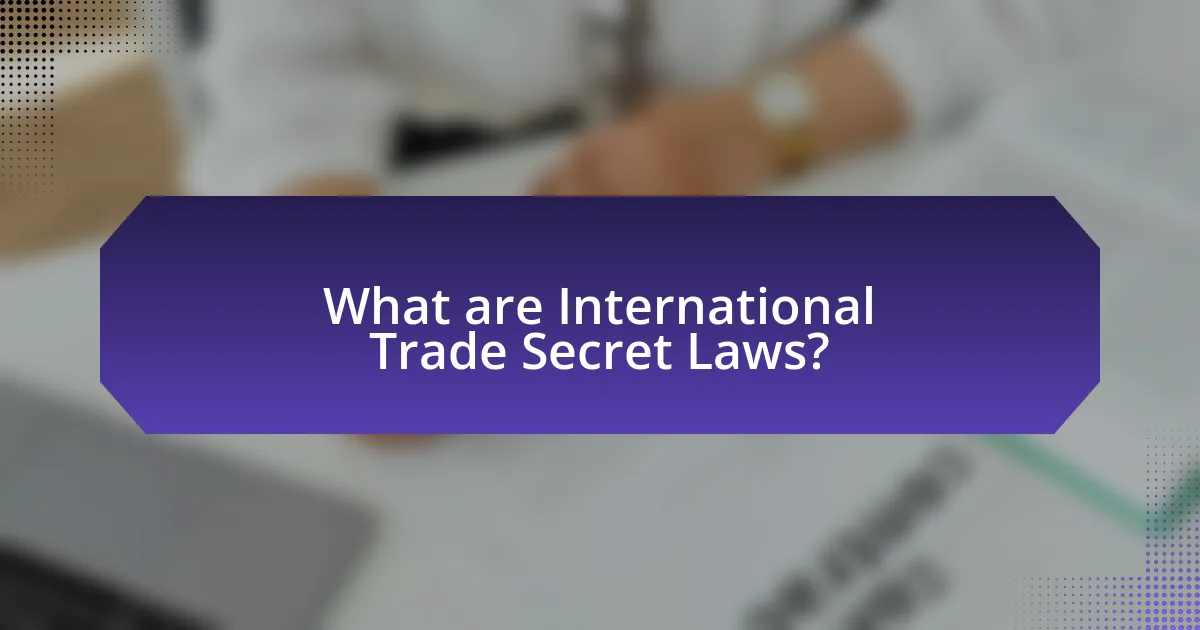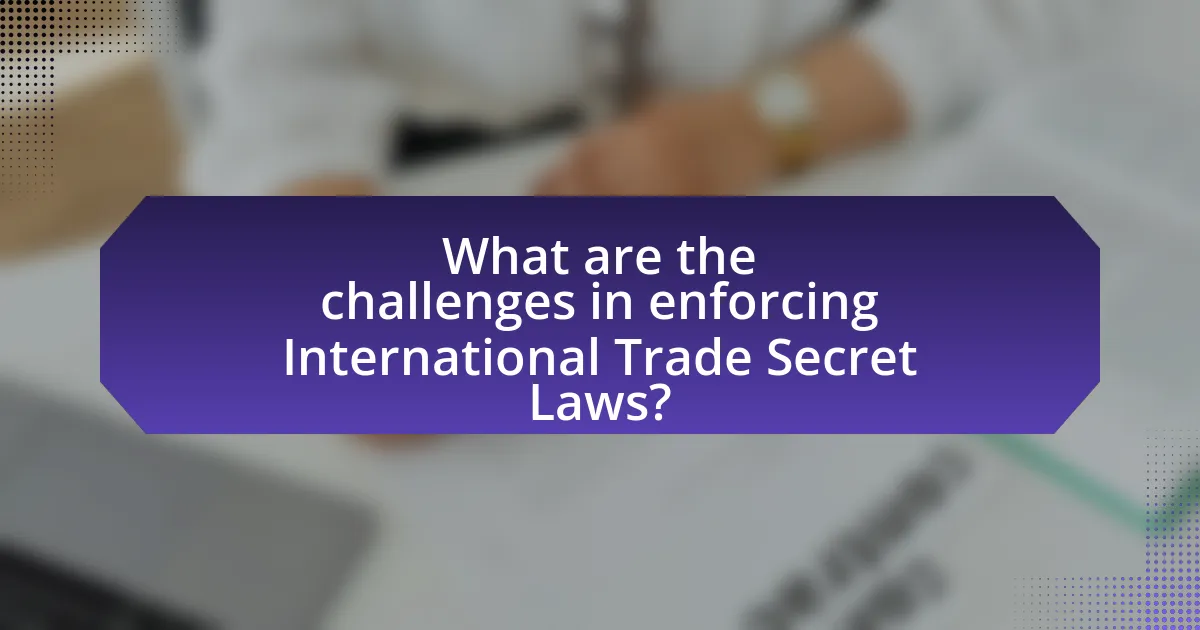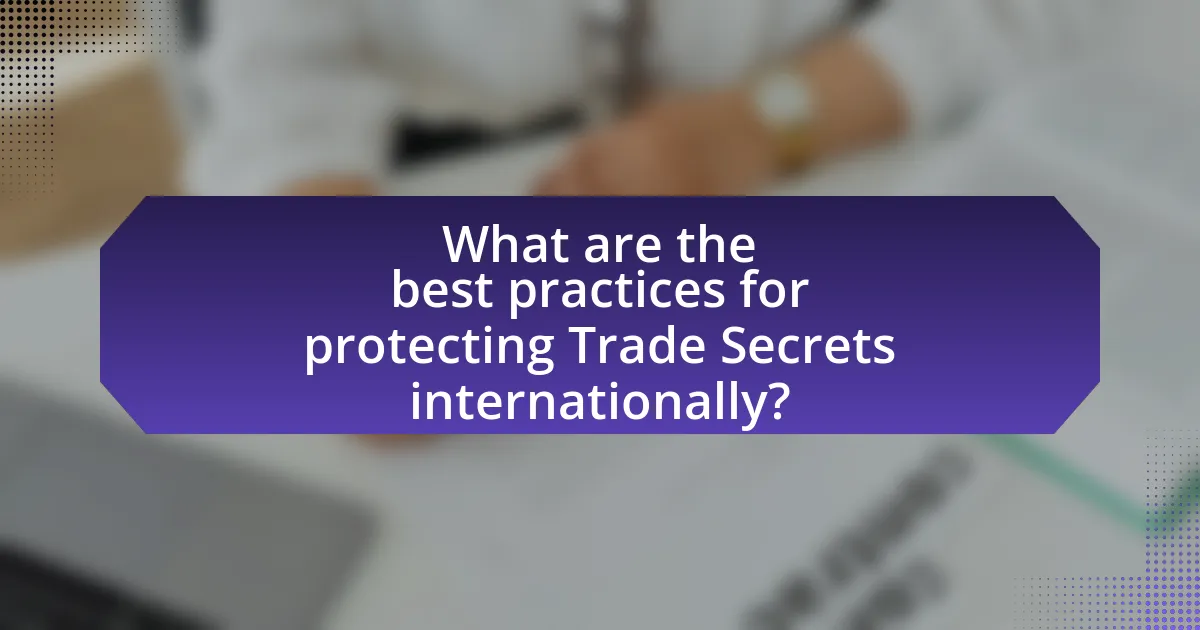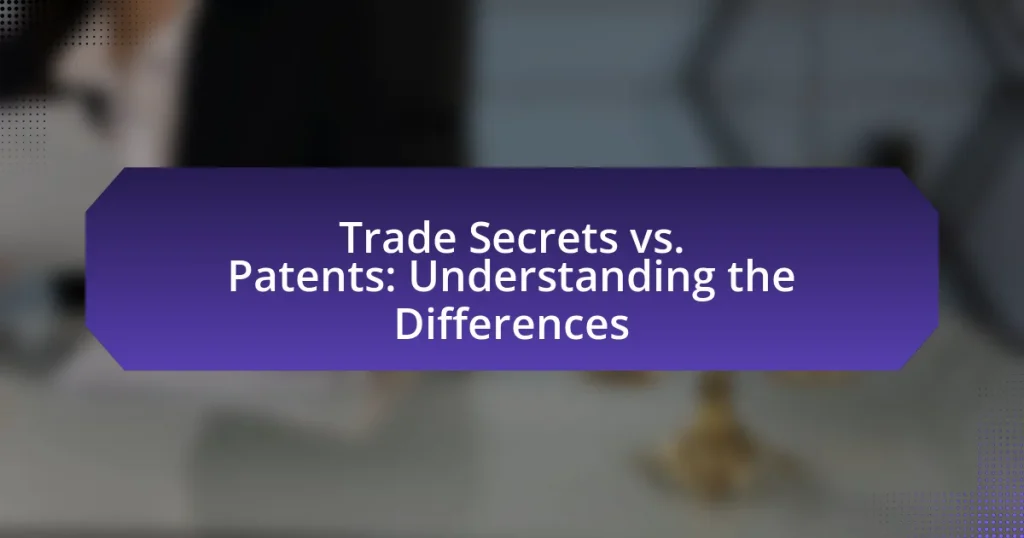International Trade Secret Laws are legal frameworks designed to protect confidential business information from unauthorized use or disclosure across borders. This article provides a comparative analysis of these laws, highlighting their variations across jurisdictions, particularly between the United States and the European Union. Key components such as definitions, protection mechanisms, and enforcement challenges are examined, along with the implications of misappropriation and the importance of robust protection strategies for businesses. Additionally, the article discusses the role of cultural differences and international cooperation in enforcing trade secret laws, as well as best practices for companies to safeguard their proprietary information effectively.

What are International Trade Secret Laws?
International Trade Secret Laws are legal frameworks that protect confidential business information from unauthorized use or disclosure across international borders. These laws vary by jurisdiction but generally aim to safeguard trade secrets, which can include formulas, practices, processes, designs, instruments, or patterns that provide a competitive advantage. For instance, the Agreement on Trade-Related Aspects of Intellectual Property Rights (TRIPS) establishes minimum standards for trade secret protection among World Trade Organization (WTO) members, requiring countries to provide legal means to protect undisclosed information. This international agreement underscores the importance of harmonizing trade secret laws to facilitate global commerce and protect intellectual property rights effectively.
How do International Trade Secret Laws differ across countries?
International trade secret laws differ significantly across countries in terms of definition, protection mechanisms, and enforcement. For instance, the United States defines trade secrets under the Uniform Trade Secrets Act, emphasizing the need for reasonable efforts to maintain secrecy, while the European Union’s Trade Secrets Directive provides a broader definition and focuses on the protection of confidential business information. Additionally, countries like China have specific laws that incorporate trade secrets within their intellectual property framework, but enforcement can vary widely, often influenced by local business practices and judicial systems. These differences highlight the complexities of navigating international trade secret protections, as evidenced by varying legal standards and the effectiveness of enforcement in different jurisdictions.
What are the key components of Trade Secret Laws in the United States?
The key components of Trade Secret Laws in the United States include the definition of a trade secret, the requirement for reasonable efforts to maintain its secrecy, and the legal protections against misappropriation. A trade secret is defined as information that derives independent economic value from not being generally known or readily ascertainable, and is subject to reasonable efforts to maintain its secrecy, as outlined in the Uniform Trade Secrets Act (UTSA) and the Defend Trade Secrets Act (DTSA). Legal protections against misappropriation involve civil remedies for unauthorized acquisition, disclosure, or use of trade secrets, which can include injunctions and monetary damages. These laws aim to balance the interests of businesses in protecting their confidential information with the need for fair competition.
How do European Trade Secret Laws compare to those in the United States?
European Trade Secret Laws generally provide broader protections compared to those in the United States. In Europe, the Trade Secrets Directive (2016/943) establishes a harmonized legal framework that emphasizes the protection of confidential business information across member states, requiring measures to prevent unlawful acquisition, use, or disclosure of trade secrets. In contrast, U.S. trade secret law is primarily governed by the Uniform Trade Secrets Act (UTSA) and the Defend Trade Secrets Act (DTSA), which focus on misappropriation and do not mandate specific protective measures, leading to a more fragmented approach across states. The European framework also includes provisions for civil remedies and criminal sanctions, while U.S. law primarily offers civil remedies, which can result in less stringent enforcement.
Why are International Trade Secret Laws important for businesses?
International Trade Secret Laws are crucial for businesses because they protect confidential information that provides a competitive advantage. These laws enable companies to safeguard proprietary processes, formulas, and strategies from unauthorized use or disclosure, which is essential for maintaining market position and profitability. For instance, the World Intellectual Property Organization (WIPO) highlights that robust trade secret protections can lead to increased innovation and investment, as businesses feel secure in developing new products and services without the fear of losing their competitive edge.
What risks do companies face without adequate Trade Secret protection?
Companies face significant risks without adequate Trade Secret protection, including loss of competitive advantage, financial losses, and potential legal liabilities. The absence of protection allows competitors to access and exploit proprietary information, which can lead to market share erosion and diminished profitability. For instance, a study by the Economic Espionage Act of 1996 indicates that U.S. businesses lose an estimated $300 billion annually due to trade secret theft. Furthermore, without legal recourse, companies may struggle to enforce their rights, leading to increased vulnerability to corporate espionage and unauthorized disclosures.
How do Trade Secret Laws impact innovation and competition?
Trade secret laws significantly impact innovation and competition by providing legal protection for confidential business information, which incentivizes companies to invest in research and development. When businesses know their proprietary information is safeguarded, they are more likely to innovate, as they can reap the benefits of their investments without the fear of competitors easily replicating their ideas. For instance, the Uniform Trade Secrets Act in the United States allows companies to protect formulas, practices, and processes, fostering a competitive environment where innovation thrives. Additionally, a study by the World Intellectual Property Organization found that strong trade secret protections correlate with increased innovation outputs in various industries, demonstrating that these laws play a crucial role in maintaining competitive advantages and driving economic growth.

What are the challenges in enforcing International Trade Secret Laws?
Enforcing International Trade Secret Laws faces significant challenges due to varying legal frameworks across jurisdictions. Different countries have distinct definitions of what constitutes a trade secret, leading to inconsistencies in protection and enforcement. For instance, the United States follows the Uniform Trade Secrets Act, while the European Union has the Trade Secrets Directive, which may not align in terms of scope and remedies. Additionally, the lack of harmonization in international treaties complicates cross-border enforcement, as companies may struggle to navigate differing legal standards and procedural requirements. Furthermore, proving misappropriation often requires extensive evidence, which can be difficult to obtain, especially in jurisdictions with limited discovery processes. These factors collectively hinder effective enforcement of trade secret protections on an international scale.
How do cultural differences affect the enforcement of Trade Secret Laws?
Cultural differences significantly affect the enforcement of Trade Secret Laws by influencing perceptions of confidentiality and competitive behavior. In collectivist cultures, such as those in East Asia, there is often a stronger emphasis on group harmony and loyalty, which can lead to more lenient views on the sharing of trade secrets within networks, potentially undermining strict enforcement. Conversely, in individualistic cultures like the United States, there is a heightened focus on personal rights and proprietary information, resulting in more rigorous enforcement of trade secret protections. This divergence is evidenced by varying legal frameworks; for instance, the Uniform Trade Secrets Act in the U.S. provides a clear legal basis for enforcement, while countries with less stringent laws may prioritize relationship-building over legal recourse. Thus, cultural attitudes shape both the interpretation and application of trade secret laws across different jurisdictions.
What role does international cooperation play in Trade Secret enforcement?
International cooperation plays a crucial role in trade secret enforcement by facilitating cross-border legal frameworks and collaboration among jurisdictions. This cooperation enables countries to share information, resources, and best practices, which enhances the effectiveness of protecting trade secrets globally. For instance, the Agreement on Trade-Related Aspects of Intellectual Property Rights (TRIPS) establishes minimum standards for trade secret protection, encouraging member countries to align their laws and enforcement mechanisms. Additionally, international treaties and organizations, such as the World Intellectual Property Organization (WIPO), promote harmonization of trade secret laws, making it easier for businesses to navigate legal challenges in different countries. This collaborative approach is essential for addressing the complexities of trade secret theft, which often occurs across borders, thereby ensuring that companies can effectively safeguard their proprietary information on a global scale.
How do legal loopholes impact the effectiveness of Trade Secret protection?
Legal loopholes significantly undermine the effectiveness of Trade Secret protection by allowing unauthorized access or use of confidential information without legal repercussions. For instance, if a jurisdiction lacks stringent definitions or enforcement mechanisms for what constitutes a trade secret, competitors may exploit this ambiguity to gain access to sensitive information without facing penalties. A notable example is the Uniform Trade Secrets Act in the United States, which varies in implementation across states; some states may not provide adequate remedies for misappropriation, leading to inconsistent protection. This inconsistency can embolden entities to infringe on trade secrets, knowing that legal recourse may be limited or ineffective.
What are the common legal disputes related to Trade Secrets?
Common legal disputes related to trade secrets include misappropriation, breach of confidentiality agreements, and disputes over employee mobility. Misappropriation occurs when a party improperly acquires or discloses trade secrets, often leading to litigation to protect proprietary information. Breach of confidentiality agreements arises when individuals or entities violate contracts designed to protect trade secrets, resulting in legal action to enforce those agreements. Disputes over employee mobility involve conflicts when former employees take trade secrets to new employers, prompting lawsuits to prevent unfair competition and protect intellectual property. These disputes are prevalent in various industries, highlighting the importance of robust legal frameworks to safeguard trade secrets.
How do companies typically resolve Trade Secret disputes?
Companies typically resolve trade secret disputes through negotiation, litigation, or alternative dispute resolution methods such as mediation or arbitration. Negotiation allows parties to reach a mutually agreeable solution without formal proceedings, while litigation involves filing a lawsuit in court to seek legal remedies. Alternative dispute resolution methods, like mediation, facilitate discussions between parties with the help of a neutral third party, and arbitration results in a binding decision made by an arbitrator. According to the Uniform Trade Secrets Act, which has been adopted by many states, companies can seek injunctions and damages in court to protect their trade secrets, reinforcing the legal framework for resolving such disputes.
What are the implications of misappropriation of Trade Secrets?
The implications of misappropriation of trade secrets include legal consequences, financial damages, and reputational harm to the involved parties. Legally, the owner of the trade secret can pursue civil litigation, which may result in injunctions against the misappropriator and monetary compensation for losses incurred. Financially, companies may face significant costs related to litigation and potential settlements, as evidenced by cases like E.I. du Pont de Nemours and Company v. Kolon Industries, where DuPont was awarded $919 million for trade secret theft. Additionally, reputational harm can lead to loss of customer trust and competitive advantage, impacting long-term business viability.

What are the best practices for protecting Trade Secrets internationally?
The best practices for protecting trade secrets internationally include implementing robust confidentiality agreements, conducting regular employee training on trade secret protection, and establishing strong internal security measures. Confidentiality agreements legally bind employees and partners to protect sensitive information, reducing the risk of unauthorized disclosure. Regular training ensures that all personnel understand the importance of trade secrets and the protocols for safeguarding them. Strong internal security measures, such as access controls and monitoring systems, further protect sensitive information from potential breaches. According to the World Intellectual Property Organization, effective trade secret protection is crucial for maintaining competitive advantage in the global market.
How can companies develop effective Trade Secret protection strategies?
Companies can develop effective trade secret protection strategies by implementing comprehensive confidentiality agreements, conducting regular employee training, and establishing robust internal security measures. Confidentiality agreements ensure that employees and third parties are legally bound to protect sensitive information, reducing the risk of unauthorized disclosure. Regular training programs educate employees about the importance of trade secrets and the specific practices required to safeguard them, fostering a culture of awareness and responsibility. Additionally, robust internal security measures, such as access controls, encryption, and monitoring systems, help prevent unauthorized access to trade secrets. According to the Economic Espionage Act of 1996, the legal framework emphasizes the importance of protecting trade secrets, highlighting the need for companies to adopt proactive strategies to mitigate risks associated with information theft.
What role does employee training play in safeguarding Trade Secrets?
Employee training plays a critical role in safeguarding trade secrets by educating employees on the importance of confidentiality and the specific practices required to protect sensitive information. Effective training programs ensure that employees understand the legal implications of trade secrets, the company’s policies regarding information security, and the potential consequences of unauthorized disclosure. Research indicates that organizations with comprehensive training programs experience fewer incidents of trade secret theft, as employees are more aware of their responsibilities and the protocols for handling confidential information. For instance, a study by the Ponemon Institute found that companies with robust security training programs reduced the risk of data breaches by up to 45%. This highlights the direct correlation between employee training and the protection of trade secrets, reinforcing the necessity of ongoing education in maintaining competitive advantage and legal compliance.
How can companies utilize non-disclosure agreements effectively?
Companies can utilize non-disclosure agreements (NDAs) effectively by clearly defining the confidential information to be protected, specifying the obligations of the parties involved, and establishing the duration of confidentiality. By explicitly outlining what constitutes confidential information, companies reduce ambiguity and enhance enforceability. For instance, NDAs should detail whether the information includes trade secrets, business strategies, or proprietary data. Additionally, specifying the obligations ensures that all parties understand their responsibilities regarding the handling of confidential information, which can prevent potential breaches. Establishing a reasonable duration for the confidentiality obligation is also crucial, as it aligns with the nature of the information being protected. According to a study by the International Association for the Protection of Intellectual Property, well-structured NDAs can significantly reduce the risk of information leaks and enhance trust in business relationships.
What resources are available for companies navigating Trade Secret laws?
Companies navigating Trade Secret laws can access various resources, including legal databases, industry associations, and government agencies. Legal databases such as Westlaw and LexisNexis provide comprehensive information on trade secret case law and statutes, enabling companies to stay informed about legal precedents. Industry associations like the International Trademark Association (INTA) and the American Intellectual Property Law Association (AIPLA) offer guidance, best practices, and networking opportunities for businesses dealing with trade secrets. Additionally, government agencies such as the United States Patent and Trademark Office (USPTO) provide educational materials and resources on trade secret protection, including the Defend Trade Secrets Act of 2016, which enhances legal protections for trade secrets. These resources collectively support companies in understanding and complying with trade secret laws effectively.
How can legal counsel assist in Trade Secret protection efforts?
Legal counsel can assist in trade secret protection efforts by providing expertise in drafting and enforcing non-disclosure agreements (NDAs) and other legal documents that safeguard confidential information. They ensure that businesses implement appropriate security measures and policies to protect trade secrets, which is critical for compliance with laws such as the Defend Trade Secrets Act in the United States. Legal counsel also offers guidance on employee training regarding the handling of sensitive information, helping to mitigate risks of inadvertent disclosure. Furthermore, they can represent businesses in litigation to enforce trade secret rights, as evidenced by cases where legal representation has successfully defended against misappropriation claims, reinforcing the importance of legal counsel in maintaining competitive advantage.
What organizations provide support for understanding Trade Secret laws?
Organizations that provide support for understanding Trade Secret laws include the American Bar Association (ABA), which offers resources and publications on intellectual property law, including trade secrets. The International Trademark Association (INTA) also provides educational materials and forums for discussing trade secret issues. Additionally, the World Intellectual Property Organization (WIPO) offers guidance on international trade secret protections and best practices. These organizations contribute to a comprehensive understanding of trade secret laws through their resources, events, and expert insights.
What are the key takeaways for businesses regarding International Trade Secret Laws?
Key takeaways for businesses regarding International Trade Secret Laws include the necessity of implementing robust protection measures for confidential information, as laws vary significantly across jurisdictions. Businesses must understand that trade secret protection is contingent upon maintaining secrecy and can be lost if information is disclosed without appropriate safeguards. Additionally, companies should be aware of the legal frameworks in countries where they operate, as some nations may offer stronger protections than others, impacting their competitive advantage. For instance, the Uniform Trade Secrets Act in the United States provides a clear legal framework, while the European Union’s Trade Secrets Directive harmonizes protections across member states. Understanding these differences is crucial for businesses to effectively manage their intellectual property and mitigate risks associated with trade secret theft.



